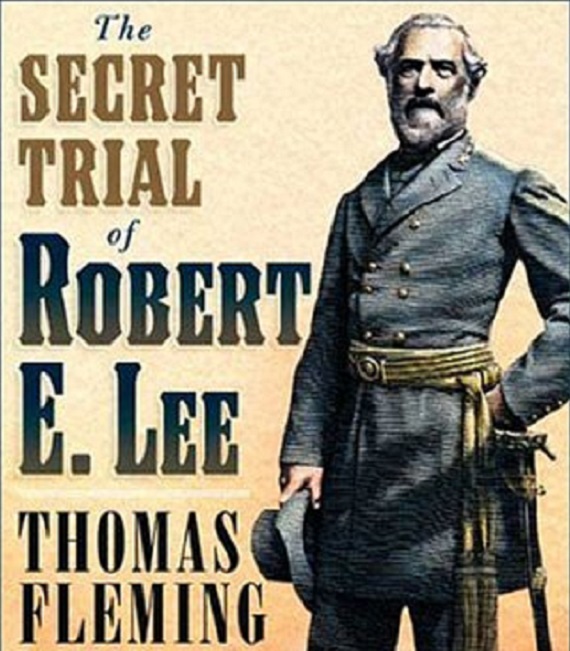A review of The Secret Trial of Robert E. Lee (Forge Books, 2006) by Thomas Fleming
Fleming uses this 2006 fictional courtroom drama to formulate arguments for his 2013 Disease in the Public Mind non-fiction book identifying the causes of the Civil War. The story is set in early June 1865 when Robert E. Lee is secretly tried by a military commission prompted by Assistant War Secretary and former editor of the New York Tribune, Charles Dana. Lincoln is dead. Andrew Johnson is in the early stages of shaping his presidency while Radical Republicans use the trial as one way to work behind the scenes to gain control of the federal government.
As a leading Radical, Dana insists upon a military tribunal for two reasons. First, if Lee were tried in a civilian court it would have to be in Virginia where a jury would likely acquit him. Second, a military commission provides the prosecution important advantages. For example, the Judge Advocate (prosecutor) is empowered to rule upon the admissibility of evidence, instead of an independent Judge.
Although Ulysses Grant objects to the trial for violating his Appomattox surrender terms, Dana silences him. Specifically, Dana threatens to recant his earlier field reports protecting the general when Dana had falsely denied Grant’s episodic drunkenness during the war. The five-officer tribunal is composed of one fictional character and Generals O. O. Howard, Ambrose Burnside, George Meade and William “Baldy” Smith. The Judge Advocate General is Joseph Holt who is assisted by General Ben “Beast” Butler. Holt had earlier prosecuted Lincoln’s assassins. The specifications against Lee are: betraying his allegiance oath, prolonging an un-winnable war after Gettysburg, responsibility for Andersonville deaths, conspiring to assassinate Lincoln, unlawful execution of prisoners, and his immoral defense of slavery. Lee is defended by Maryland Senator Reverdy Johnson who was counsel for the white defendant in the 1857 Dred Scott case.
Fleming masterfully portrays the prosecution and defense cases of Butler and Johnson, respectively. After questioning a parade of witnesses that include Ulysses Grant, Horace Greeley, Charles Dana, Pete Longstreet, John Mosby, Jefferson Davis, Lewis Powell, Robert E. Lee, Henry Wirz, Edmund Ruffian, Charles Taylor, Wingfield Scott, Julia Tyler, and Mary Anna Custis Lee, among others, it seems likely that Lee will be acquitted of all charges except defending slavery. After four years of the worst casualties in America history, Ben Butler’s argument that slavery was a crime against humanity that merits conviction gains purchase with the judges.
After Mary Lee testifies that Southern women were genuinely fearful of slave rebellions, however, the judges begin to see merit in her argument that growing Northern fanaticism made such uprisings more likely. Reverdy Johnson explains that blacks outnumbered whites five-to-one, or more, in parts of the South. If America’s black population was not permitted to naturally diffuse to other parts of the country—even as free men—they will become increasingly concentrated in the South thereby intensifying the region’s worries over a race war.
In a private conversation, Dana explains to a fictional character that even though Northerners want to end slavery, they don’t want ex-slaves to leave the South and migrate into their own states. In actual history, Adjutant General Lorenzo Thomas conceded the point when he was sent South by Lincoln during the war to recruit black soldiers. Even though the families of ex-slaves desperately needed subsistence he wrote Lincoln explaining that the Northern states would not accept them as refugees.
Only a couple of months before the war started, former President John Tyler explained that John Brown’s 1859 attempted slave insurrection amplified Southern worries. He urged that Northerners ease such concerns by investigating the six abolitionist leaders who allegedly backed Brown. According to Fleming, during the secession crisis Tyler requested that The New York Tribune print an editorial asking for such an investigation, but Charles Dana turned him down. Additionally, Dana failed to tell Greeley of the request, even though the latter would have complied. Greeley’s newspaper was America’s most influential media in 1861.
As a harbinger of his analysis seven years later in A Disease in the Public Mind, several of Fleming’s characters engage in an insightful conversation near the end of his Lee-trial novel:
“We’ve killed six hundred thousand men to free four million slaves—and no one has a clue what to do with them! Or for them!” Stapleton said.







